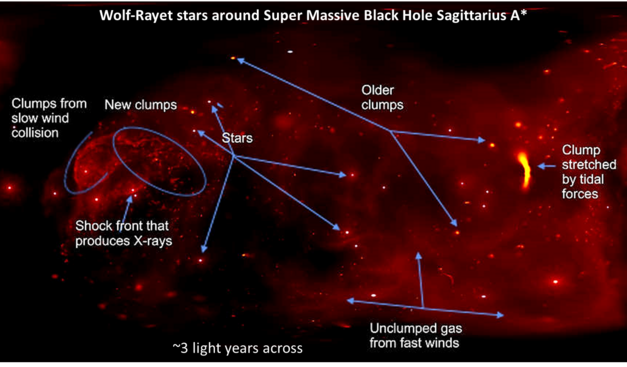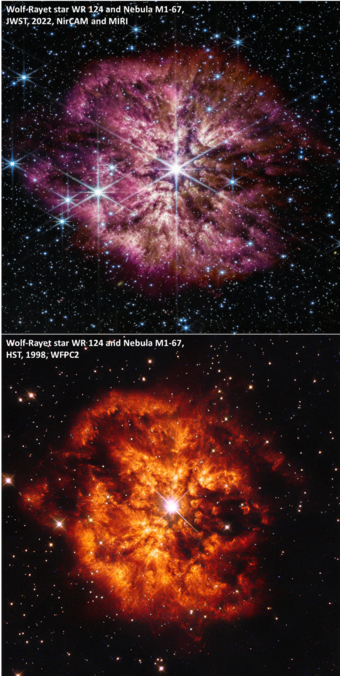AkaSci · @AkaSci
1000 followers · 910 posts · Server fosstodon.orgDozens of massive Wolf-Rayet stars are known to orbit within 1.5 ly of the central super massive black hole Sgr A* in our own galaxy.
The fierce stellar winds of the WR stars collide with each other creating shock waves and clumps of gas and dust, which heat up to millions of degrees and emit X-rays.
Some of these clumps spiral into the black hole. Some of the material gets ejected into interstellar space.
https://chandra.harvard.edu/photo/2018/gcenter360/
#JWST #WR124 #WolfRayet #SgrA*
4/n
AkaSci · @AkaSci
999 followers · 909 posts · Server fosstodon.orgThis study from 2012 revealed that the ionized gas of nebula M1-67 ejected by WR 124 is condensed in knots aligned in a preferred axis along the NE-SW direction and with “holes” along the perpendicular direction.
The sketch below illustrates the (proposed) structure as an inner region with bipolar or elliptical shape along the direction NE−SW surrounded by an external spherical bubble.
https://www.aanda.org/articles/aa/pdf/2013/06/aa20773-12.pdf
#JWST #WR124
3/n
Steve Laskevitch · @stevelaskevitch
26 followers · 155 posts · Server universeodon.comWhen #WR124 does go #supernova will it be visible to the naked eye? #astrophysics #astronomy
#wr124 #supernova #astrophysics #astronomy
AkaSci · @AkaSci
999 followers · 907 posts · Server fosstodon.orgThe Wolf-Rayet star WR 124 :
Distance: 15,000 light-years, in the constellation Sagittarius.
Discovered by : Paul W. Merrill in 1938.
Mass : 30x solar mass ☉; has shed 10☉ worth of material so far.
Temp: 44,700 K
Elements: 15% hydrogen, rest is mainly helium.
https://en.wikipedia.org/wiki/WR_124
#JWST #WR124
2/n
AkaSci · @AkaSci
999 followers · 906 posts · Server fosstodon.orgThis image of the Wolf-Rayet star WR 124 and the surrounding Nebula M1-67 was released by the JWST team today at #SXSW. The image was taken using the NirCAM and MIRI instruments in June 2022.
The 2nd image was taken by Hubble in 1998 and re-processed in 2015.
The massive young hot star is expelling star-stuff at ~200 km/s into the surrounding nebula.
It will explode as a type Ib or Ic supernova in a few 100,000 years.
https://esawebb.org/news/weic2307/
https://esahubble.org/images/potw1533a/
#JWST #WR124
1/n



